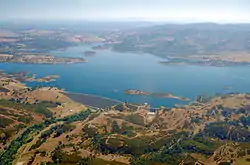Calaveras River
The Calaveras River is a river in the San Joaquin Valley of California.
| Calaveras River | |
|---|---|
 New Hogan Lake, the main reservoir on the Calaveras River | |
| Location | |
| Country | United States |
| State | California |
| Physical characteristics | |
| Source | Confluence of North and South Forks |
| • location | West of San Andreas |
| • coordinates | 38°11′50″N 120°43′12″W[1] |
| • elevation | 705 ft (215 m) |
| Mouth | San Joaquin River |
• location | Near Stockton |
• coordinates | 37°58′01″N 121°22′04″W[1] |
| Length | 51.9 mi (83.5 km) |
| Basin size | 470 sq mi (1,200 km2) |
| Discharge | |
| • location | Jenny Lind, CA |
| • average | 225 cu ft/s (6.4 m3/s) |
| • minimum | 0 cu ft/s (0 m3/s) |
| • maximum | 50,000 cu ft/s (1,400 m3/s) |
It flows roughly southwest for 51.9 miles (83.5 km) from the confluence of its north and south forks in Calaveras County to its confluence with the San Joaquin River in the city of Stockton.[2]
The Spanish word calaveras means "skulls." The river was said to have been named by Spanish explorer Gabriel Moraga in 1806 when he found many skulls of Native Americans along its banks. He believed they had either died of famine or been killed in tribal conflicts over hunting and fishing grounds.
Later, human remains were of the native Miwuk people killed by Spanish soldiers after they banded together to rise against Spanish missionaries. The Stanislaus River is named for Estanislau, a coastal Miwuk who escaped from Mission San Jose in the late 1830s. He is reported to have raised a small group of men with crude weapons, hiding in the foothills when the Spanish attacked. The Miwuk were quickly decimated by Spanish gunfire.
In 1836, John Marsh, Jose Noriega, and a party of men, went exploring in Northern California. They made camp along a river bed in the evening, and when they woke up the next morning, discovered that they had camped in the midst of a great quantity of skulls and bones. They also gave the river the appropriate name: Calaveras.[3][4][5]
New Hogan Lake is the only lake on the river. It is formed by New Hogan Dam, which was completed in 1963. The dam was built by the United States Army Corps of Engineers, primarily for flood control. The dam also provides drinking water, water for irrigation, hydroelectricity and recreation, including fishing, camping, swimming and water skiing.
The Mormon Slough, a distributary of the Calaveras, splits away about five miles east of Linden, California. In east Stockton, the Stockton Diverting Canal reconnects the Mormon Slough and the Calaveras. Downstream from this flood control channel, the often dry Mormon Slough continues on its southerly path, through downtown, to the Stockton Channel. The Calaveras makes a northerly arc, passing through farmland, orchards, and the University of the Pacific Stockton Campus, then alongside its namesake Brookside district, before flowing into the Deepwater Channel about three miles downriver from the Mormon Slough. Thus much of central Stockton, being completely surrounded by these waterways, is itself one of the many river islands which make up the San Joaquin Delta.
References
- U.S. Geological Survey Geographic Names Information System: Calaveras River
- U.S. Geological Survey. National Hydrography Dataset high-resolution flowline data. The National Map Archived 2012-03-29 at the Wayback Machine, accessed March 11, 2011
- Lyman, George D. John Marsh, Pioneer: The Life Story of a Trail-blazer on Six Frontiers, pp. 207-8, The Chautauqua Press, Chautauqua, New York, 1931.
- Winkley, John W., Dr. John Marsh: Wilderness Scout, pp. 54-5, The Parthenon Press, Nashville, Tennessee, 1962.
- Thompson, Thomas Hinkley, and West, Albert Augustus. History of San Joaquin County, California, p. 13, 1879.